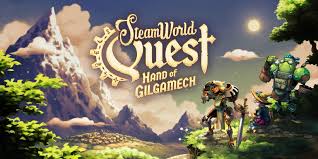Image & Form have spent the last several years not only trying but mastering their hand at producing outstanding video games from a variety of genres. Dungeon crawler, RPG, strategy. Game after game they’ve defied the odds to deliver unique play and varied design. The only commonality among them (aside from the sequel Steamworld Dig 2) has been the ‘Steamworld’ style.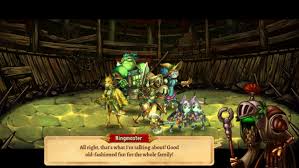
Steamworld Quest Hand of Gilgamech is no different. It’s yet another adventure into the unknown for Image & Form with only the familiar art style and charm of SteamWorld to guide them. It meets the expectation of quality and fun that fans have come to expect in a completely new gameplay package. It’s an RPG card game where the player leads a party of unlikely heroes through an animated steampunk-fantasy style world.
While the art direction is familiar to any fan of the series, the gameplay is anything but. Each of the heroes in the player’s party has a deck size of eight, no more no less. During the battle, the player has access to 24 of those cards (the combined total of all active party member’s decks). However, the player’s hand size is (typically) six meaning there’s a fair amount of strategy required in ensuring you’re building a deck that’s not only strong enough to defeat your opponent’s and protect your heroes but more importantly that the cost of cards is evenly distributed such that the player has multiple cards to play every turn.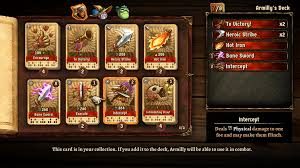
Playing 3 cards every turn can be tricky because more powerful cards require steam to play. Steam is a resource that builds as players (and enemies) play basic cards. The more basic cards that are played the more steam that’s generated. Over several turns of play, the player may have enough steam to play cards that cost 4,5, or even 6 steam. But after steam is spent the player has to start building it again. The deepest part of The Hand of Gilgamech’s strategy isn’t steam or deck combination however, it’s combo effects and bonus effects.
Whenever three cards from a single hero are played in a turn that hero automatically plays a combo card that’s unique to that hero. It may allow for an extra attack, it could provide a shield to your allies, or allow a hero to play an additional card next turn. Whatever the effect, they are all very powerful and well worth prioritizing.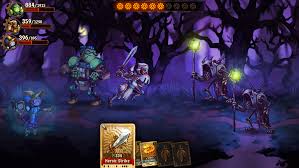
Combos are similar to bonus effects but are triggered by playing cards from opposite heroes instead of the same one. When the player plays a card with a combo effect in most situations it simply has an effect like any other card (dealing damage, healing, poisoning etc). However, if a card with a combo ability is played in conjunction with another from a specified hero a bonus effect will occur. For instance, a damage dealing card may have the combo effect that raises the team’s evasion. A card that provides a shield may also heal if it’s played after another hero has acted.
If all of this sounds confusing it’s because I’m compressing into a few paragraphs game mechanics rolled out over nearly 20 hours of play. One of the most impressive bits about SteamWorld Quest is that it does a great job of introducing what is ultimately a fairly complex card-based strategy game to the player quickly and clearly. Once players have mastered the basics there are a healthy amount of cards to find in the game and buy with currency exclusively found within the game.
These extra cards and the variance in tactics they support is where Steam World Quest really shines and what gives the entire experience legs. This is not just an RPG that uses cards in place of menu options. The large number of strategies that the player can build their deck around, with what is realistically a modest amount of cards overall, makes it fun to repeat encounters and saves the game from feeling too difficult. If you hit a boss that’s too hard, you can grind all you like but it won’t help. Instead what’s required is going back to the drawing board and building your deck (as best you can) to directly counter theirs.
Often times in my playthrough I found myself with a deck that was crushing enemies for a few hours and I’d start to get 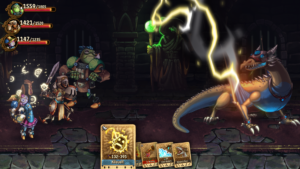 bored until I’d hit another area or boss that challenged me to rethink the way my deck was built, and how my heroes interacted. However, what is Steam World Quest’s greatest strength (that it’s a very fun card game) is also its greatest weakness.
bored until I’d hit another area or boss that challenged me to rethink the way my deck was built, and how my heroes interacted. However, what is Steam World Quest’s greatest strength (that it’s a very fun card game) is also its greatest weakness.
I call the great gameplay a weakness because the game as a whole leans so heavily on that aspect making the story and environments feel generic and forgettable. There are some funny one-liners here and there and the main heroes have interesting visual designs, but the world around them never interested me, nor did the overarching plot. Luckily the game doesn’t push it too hard and ultimately cuts dialogue short so it doesn’t wear out its welcome.
In summation, I can’t recommend Steamworld quest enough if you like card games or are a fan of the steam world series. Even if you like RPGs generally I think the mechanics are similar enough to not feel too intimidating but the deck building will keep you interested. It really is another Switch indy gem that I recommend anyone with remote interest check out.

